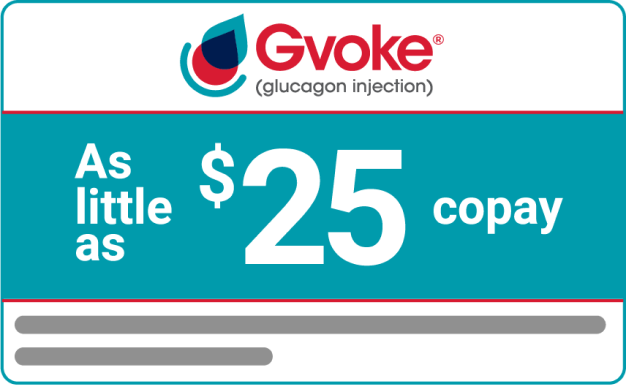Access Savings for Gvoke HypoPen®
Eligible commercially insured patients may pay as little as $25 with this Copay Card*
If you have questions about the savings card, call us at 1-877-myGVOKE (1-877-694-8653).
Need Help Paying for Gvoke HypoPen?
A Patient Assistance Program is available for those who need financial support. See if you qualify.

3 Steps To Ensure You’re Ready To Treat Severe Low Blood Sugar
If you and your doctor have decided that Gvoke HypoPen is right for you, here’s what to do:
1. Fill your prescription
Fill your Gvoke HypoPen prescription right away.
2. Keep it on hand
Carry Gvoke HypoPen with you no matter where you go.
3. Educate others
Ensure those around you know how to use Gvoke HypoPen.
Build Knowledge and Confidence With Diabetes Resources

Read the Gvoke HypoPen guide
Review our quick guide for treating very low blood sugar.

*Offer not valid for prescriptions reimbursed under Medicaid, a Medicare drug benefit plan, TRICARE, or other federal or state health programs (such as medical assistance programs).
INDICATION AND SAFETY SUMMARY
GVOKE is a prescription medicine used to treat very low blood sugar (severe hypoglycemia) in adults and kids with diabetes ages 2 years and above. It is not known if GVOKE is safe and effective in children under 2 years of age.
WARNINGS
Do not use GVOKE if:
- you have a tumor in the gland on top of your kidneys (adrenal gland), called a pheochromocytoma.
- you have a tumor in your pancreas called an insulinoma.
- you are allergic to glucagon or any inactive ingredient in GVOKE.
GVOKE MAY CAUSE SERIOUS SIDE EFFECTS, INCLUDING:
High blood pressure
GVOKE can cause high blood pressure in certain people with tumors in their adrenal glands.
Low blood sugar
GVOKE can cause low blood sugar in certain people with tumors in their pancreas called insulinomas by making too much insulin in their bodies.
Serious allergic reaction
Call your doctor or get medical help right away if you have a serious allergic reaction including:
- rash
- difficulty breathing
- low blood pressure
COMMON SIDE EFFECTS
The most common side effects of GVOKE in adults include:
- nausea
- vomiting
- swelling at the injection site
- headache
The most common side effects of GVOKE in children include:
- nausea
- low blood sugar
- high blood sugar
- vomiting
- abdominal pain
- headache
- pain or redness at the injection site
- itching
These are not all the possible side effects of GVOKE. For more information, ask your doctor. Call your doctor for medical advice about side effects.
You are encouraged to report side effects of prescription drugs to the FDA. Visit www.fda.gov/medwatch, or call 1-800-FDA-1088.
BEFORE USING
Before using GVOKE, tell your healthcare provider about all your medical conditions, including if you:
- have adrenal gland problems
- have a tumor in your pancreas
- have not had food or water for a long time (prolonged fasting or starvation)
- have low blood sugar that does not go away (chronic hypoglycemia)
- are pregnant or plan to become pregnant
- are breastfeeding or plan to breastfeed. It is not known if GVOKE passes into your breast milk. You and your healthcare provider should decide if you can use GVOKE while breastfeeding.
Tell your healthcare provider about all the medicines you take, including prescription and over-the-counter medicines, vitamins, and herbal supplements.
HOW TO USE
- Read the detailed Instructions for Use that come with GVOKE.
- Use GVOKE exactly how your healthcare provider tells you to use it
- Make sure your relatives, close friends, and caregivers know where you store GVOKE and how to use it the right way before you need their help.
- Act quickly. Having very low blood sugar for a period of time may be harmful.
- Your healthcare provider will tell you how and when to use GVOKE.
- After giving GVOKE, your caregiver should call for emergency medical help right away.
- If you do not respond after 15 minutes, your caregiver may give you another dose, if available. Tell your healthcare provider each time you use GVOKE. Low blood sugar may happen again after receiving an injection of GVOKE. Your diabetes medicine may need to be changed.
HOW TO STORE
- Keep GVOKE pre-filled syringe and HypoPen in sealed foil pouch until time of use.
- Keep GVOKE kit vial and pouched syringe together in original carton until time of use.
- Store GVOKE at temperatures between 68°F and 77°F.
- Do not keep it in the refrigerator or let it freeze.
Keep GVOKE and all medicines out of the reach of children.
For more information, call 1-877-937-4737 or go to www.GvokeGlucagon.com.
Please see the Full Prescribing Information for Gvoke
